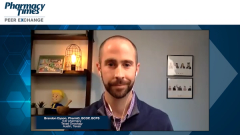
Overcoming Barriers With Adopting Biosimilars
Brandon Dyson, PharmD, BCOP, BCPS, shares his approach to switching a patient already on biologic therapy to a biosimilar, and panelists discuss the importance of education regarding the extrapolation of indications for biosimilars.
Episodes in this series

Bhavesh Shah, RPh, BCOP: One of the other questions; it’s pretty easy to start new patients on a biosimilar. But how do you actually handle patients who are on existing therapy—patients who are on Herceptin [trastuzumab], who are on bevacizumab? We already established this whole interchangeability that we may never get. What do you guys do in that setting? Brandon, do you want to lead that?
Brandon Dyson, PharmD, BCOP, BCPS: Sure. You’ve been therapeutic, you’re on Herceptin maintenance. You’ve been that way for a while, and now the time has come. Either where you’re getting treated has decided to switch, or your insurance has decided that you need to switch to a biosimilar. It’s a conversation. It has to be a conversation. But the switch ultimately is going to happen unless there’s an allergic reaction or something along those lines. You can’t really soft launch in those situations. For example, if you’re on a Q3 [every 3]-week maintenance regimen, then in 3 weeks it’s going to be this one. There is a lot of face time. There are a lot of conversations with the patient that the pharmacy was able to have to help ease concerns, to talk to them about it. I think almost the softest of launches is to say that we’re monitoring. It’s not as if the patient is not getting monitored. It’s not like we’re switching you to this and then whatever happens, happens. I think that worked really well. It was pretty easy with growth factors, like things like Retacrit [epoetin alfa-epbx] because you’re checking week to week, and you can see if they’re responding. It’s less ephemeral. Having a lot of conversations and a lot of education I think is how the switch happened.
Bhavesh Shah, RPh, BCOP: I’m sure. As I mentioned, a lot of folks struggle, and that’s why we see a lower adoption rate because maybe there are concerns from providers in that setting where they may not feel that the drug shows the same efficacy in the adjuvant setting versus the metastatic, or switching a patient who has been on therapy for years. Moving a little outside of that, I think we talked about the extrapolation of indications and skinny labeling and payer implications. Is there anything else that I may have missed on that aspect that you guys want to cover?
Tim Peterson, PharmD, BCOP: I think we touched on the extrapolation of indications, and Brandon explained nicely the secondary patents versus skinny labeling, but I think at this point it comes down to the provider education. A lot of them have already come around to it. One very good example of this is bevacizumab. The 2 biosimilars that we have for bevacizumab are not FDA approved for ovarian cancer, which is a very large subset of patients who utilize bevacizumab. Initially there was a little hesitation as to whether we should be using this. But now not only do the NCCN [National Comprehensive Cancer Network] clinical practice guidelines say you can substitute the bevacizumab biosimilars that are FDA approved independent of the fact that they’re not FDA approved for ovarian cancer. But they actually have a little blurb in there that explains what I think Bhavesh has explained numerous times in the past about biosimilars, that its extrapolation of indications is based on the assumption that the mechanism of action is no different between these indications. We know bevacizumab is a VEGF inhibitor. It’s a VEGF inhibitor when it’s used for cervical cancer; it’s a VEGF inhibitor when it’s used for ovarian cancer. They acknowledge that. With the PK/PD [pharmacokinetic/pharmacodynamic] analytical data that we have, it doesn’t matter if it’s FDA approved for ovarian cancer. We know that it’s going to work the same.
Bhavesh Shah, RPh, BCOP: There’s definitely more education we need to do around this aspect because it can be a limitation to the adoption of biosimilars when providers see that this is not indicated and question if it is because there was a clinical issue. We know it’s not because of a clinical issue; it’s a patent-related issue. Then of course there’s fear from providers that if it’s not FDA approved then the payer is not going to cover it. They may think, “Even though I know it’s not a clinical issue, I’m going to lose reimbursement,” and sometimes this is a real scenario. Perhaps there’s payer input that we need from here too that, “We’ll be able to cover it no matter what indication you’re using it for, even if it’s not on the label.” This is because it makes sense financially from a payer. If a provider wants to use a lower-cost drug, I’m not going to say, “No, use the higher cost drug.” We definitely need more education around all of those aspects with the payers and providers, as well as incorporating extrapolating indications.
Transcript edited for clarity.
Newsletter
Stay informed on drug updates, treatment guidelines, and pharmacy practice trends—subscribe to Pharmacy Times for weekly clinical insights.

















































































































































































































